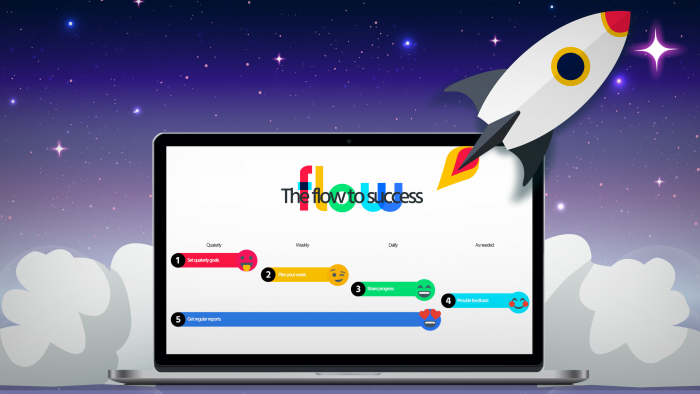
So, I was offered a growth marketing position in Weekdone about a month ago. Before joining I had zero previous contact with OKR methodology. I really took a nosedive into the theory and tried to understand how to implement it into my professional life. It all sounded fairly easy at first: set goals, explain them, write out some metrics about them, and top it off with a reasonable game plan. Off I went, thinking I’ve done this a million times (through classical to-do list logic of course), but I soon learned that it was not as easy as I first thought. I ended up learning a lot throughout my journey, and I wanted to share my OKR failures & biggest takeaways with you. So, this was my introduction to OKRs.
Ripping the band-aid off
Before I started at Weekdone, I worked as a digital strategist for one of Estonia’s biggest digital marketing agencies. Which meant a lot of client contacts and constant juggling between assignments (and I mean a lot). At some point, I completely lost sight of what really mattered for myself and the contribution that I bring to the companies objectives. My goal setting and long-term plans got replaced with daily to-do lists that would dominate my everyday life, which led to some bad habits. So, after diving head first into the methodology and trial & error, I came up with a load of Objectives & Key Results – because the more the merrier right? In a sense, I was on the right track but did the exact opposite of what I was supposed to.
My first set looked like this:
- Build a perfect google analytics account for Weekdone
- Connect sales-to-marketing data.
- Set up a company-wide UTM-sheet.
- Set up Tag Manager & micro-conversions for the blog to analyze qualitative data.
- Build custom segments & remarketing audiences.
- Set up cross domain tracking with our minisites.
- Build out marketing funnels for detailed reporting.
- Improve SEO
- Set up google data studio reports for blog & main site data to give traffic a monetary value.
- Improve Page speed score.
- Set-up actionable KPI’s & draw out a full marketing funnel.
- Link & integrate ads, search console, and other sources.
- Audit backlinks & set up an actionable roadmap to improve off-site SEO.
- Do heuristic analysis on the website to better CRO.
- Set up heat maps & analyze qualitative data in order to start A/B testing for growth
- Increase traffic & MQLs
- Create a PPC strategy.
- Research B2B software (like fastbase) to increase first contact impact.
- Start an Udemy course with our supporthero.io (https://weekdone.supporthero.io/)
- Conduct keyword research & create a content marketing prioritization worksheet.
- Propose an affiliate program offer to generate more paying customers.
While I thought I had come up with some excellent OKRs, my false sense of pride was completely demolished by Weekdone’s OKR professionals, in a good way of course. It got me thinking about the importance of metrics & quantifiable statistics that could be used afterward. So I dove deeper and tried to figure out how could I harness the best use cases to my advantage.

The second time around
After a couple of days, I was still smashing my head against the wall trying to figure out the metrics. I was so sure that the methodology couldn’t be used in my case because I was just starting at the company and my work was more research-oriented, so it was impossible to measure the Key Results with single metrics. As it turned out, I couldn’t have been more wrong. After another round of feedback, it became clear that I had made an excellent to-do list again. The whole concept was to avoid it, but there’s no way of beating habits without some good old failure. Only after the second batch of feedback did I understand the principle of how to implement OKRs the way they should be done.
The key was to cheat. Literally. I even copied one Key Result word-for-word from the Marketing section of the OKR examples site. On the other hand, the other things on my former to-do list ended up in my weekly planning section. While Key Results have to be measurable, Weekly Plans are more like to-do lists. Finally, a place where I felt like a PRO at.
What I actually discovered was that I tend to overdo things when planning. If I looked at my first set of OKRs, they might as well have been a whole year’s work. They definitely needed a run through. So after I analyzed what I had written, I discovered that when prioritizing the important stuff I can’t just list things that need to be done. I really have to think through what I can manage, where to start, and what resources I need to successfully complete my quarterly goals. So, on my third try my OKRs became:
1. Set up the perfect Google Analytics account for Weekdone
1.1 – Map & analyze all of our current marketing channels and give 10 recommendations on how to improve them
1.2 – Document clear GA views & Data Studio reports for 3 different divisions: marketing, product, sales
2. Improve blog, main page, microsites SEO
2.1 – Conduct a backlink audit & increase traffic 15% by optimizing broken backlinks
2.2 – Go through technical SEO (improve google page speed score by 50%)
2.3 – Go through picture optimization & alt text info. Fix 100% of the images
3. Optimize marketing funnels & increase MQLs by 20%
3.1 – Craft 2 strategic proposals to increase traffic
3.2 – Implement PXL framework for constant testing

While the first set of Key Results were quite vague and all over the place, the ones that I have now left room to breathe for the goals. Some of them kind of feel like mini tasks that could be handled in a day or two. But, in order to tackle them, I need thorough research and understanding of what our team is doing & where our priorities are.
Gathering courage to publish my OKRs & Key Metrics
After we had agreed on the changes, the next step was to finalize them and make them public. This ended up being a bit nerve-wracking. I wasn’t at all used to full transparency. In a sense, I was really scared to mess up, especially in front of my colleagues who breathe OKR methodology. I felt like a high schooler giving his first Powerpoint in front of my class in high school. I think I rewrote the Key Results like 2-3 times. Just to make sure, that:
a. I sound smart and professional;
b. That they could be understood by everybody reading them;
c. That they made sense, workwise.
I held my breath for a couple of seconds, and I published them. And… nothing happened. I got some feedback from my team & a couple of people actually aligned some things within the team and that was that. I had successfully managed to slip through the cracks and plan out my entire quarters’ work. Suddenly I was much more interested in what other people were doing and what their goals were. Cultural transparency helped me get acquainted faster within the company and I had the whole picture of what the company was trying to do this quarter. Which felt kind of awesome, because, usually, it takes a few hours of Powerpoint slides to get to the point.
Takeaways
In the end, it all made sense. It really did. I did not end up with a random to-do list to forget again. It turned into something useful that connected through my team to the company’s long term goals. It helped me see a clear hierarchy of how my work is correlated to everybody else. I still have a lot to learn in terms of setting OKRs & the methodology, but still. Who doesn’t like to showboat? So, I made a list of the TOP 4 things that I learned from the experience.
- Start with a list of everything and map out what needs to be done.
- Have a clear understanding of the company OKRs
- Don’t be afraid to ask for feedback – it’s a team sport, so treat it as such. Don’t overthink it – The big things are what matters. You’ll have time later, to figure out the nitty-gritty.
- Prioritize. Otherwise, you’ll end up running in the wrong direction.

Thinking back, the process actually felt quite weird. The more detailed my plans used to be, the less important stuff I got done. Now, I still do daily to-do lists, but the only difference is that now, I understand exactly what role I play on the company, team, and personal level. And more importantly, what’s my personal contribution to the vision of the company. Actually, it feels great to know that the hard work you’re putting in is harvesting real & measurable results.